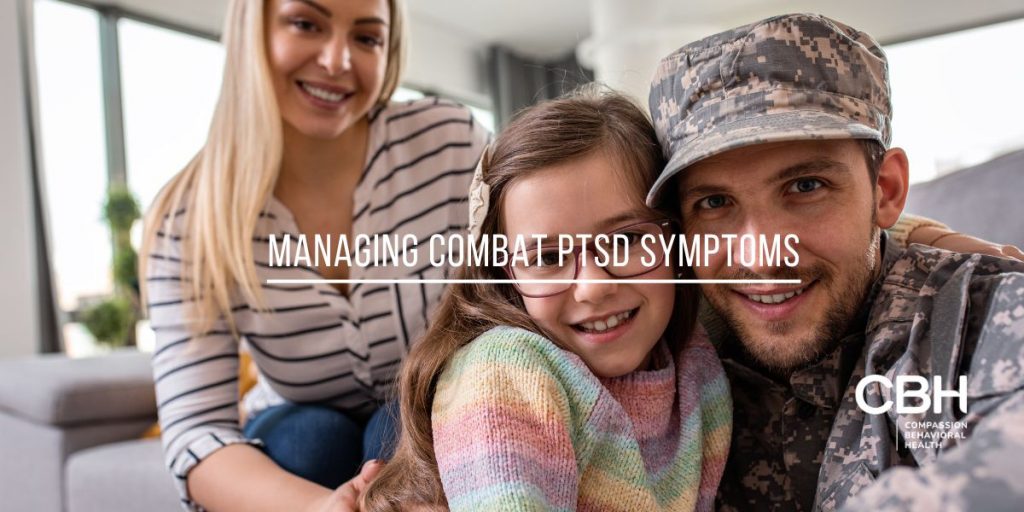Combat PTSD, or Post-Traumatic Stress Disorder, affects many individuals who have served in the military. Its symptoms can be debilitating and impact not only the affected individuals but also their families and communities. This article explores effective strategies for managing combat PTSD symptoms, beginning with an understanding of the disorder itself, followed by various management techniques, psychological approaches, medication options, and alternative therapies.
Understanding Combat PTSD
Defining Combat PTSD
Combat PTSD is a mental health condition that can occur after experiencing or witnessing traumatic events in a combat situation. Symptoms may include flashbacks, severe anxiety, nightmares, and uncontrollable thoughts about the incident. It can manifest in different ways, and not everyone exposed to combat experiences PTSD in the same manner.

According to the U.S. Department of Veterans Affairs, approximately 11-20% of veterans who served in Operations Iraqi Freedom and Enduring Freedom have PTSD in a given year, highlighting the urgent need for effective management of this condition. The nature of combat experiences, which often involve life-threatening situations and the loss of comrades, can lead to profound psychological effects that linger long after the physical battles have ended.
The Impact of Combat PTSD on Daily Life
The effects of combat PTSD can permeate various aspects of daily life, including personal relationships, work performance, and social interactions. Individuals may experience challenges such as:
- Difficulty in maintaining relationships due to trust issues or emotional withdrawal
- Challenges in the workplace, including decreased concentration and productivity
- Social isolation resulting from anxiety in public settings
Understanding these impacts is crucial in finding appropriate management strategies, enabling a better quality of life for those affected. Furthermore, the stigma surrounding mental health issues can exacerbate feelings of isolation, making it even more difficult for individuals to seek help. Many veterans may feel that their struggles are misunderstood or minimized by those who have not experienced similar traumas, leading to a reluctance to open up about their feelings and seek the support they need.
Moreover, the physiological effects of PTSD can manifest in physical health problems, such as chronic pain, cardiovascular issues, and gastrointestinal disorders. This interplay between mental and physical health underscores the importance of a holistic approach to treatment, which may include therapy, medication, and lifestyle changes. Engaging in supportive communities, whether through veteran organizations or peer support groups, can also play a vital role in recovery, providing a sense of belonging and understanding that is crucial for healing.
The Importance of Managing PTSD Symptoms
The Role of Self-Care in PTSD Management
Self-care is fundamental for managing PTSD symptoms effectively. It encompasses a range of practices that allow individuals to take care of their mental, emotional, and physical well-being. Engaging in self-care can lead to significant improvements and may include:
- Establishing a regular sleep schedule
- Incorporating healthy eating habits
- Integrating relaxation techniques into daily routines
- Setting realistic goals for personal and professional life
By prioritizing self-care, individuals can build resilience and better manage the symptoms of PTSD. Activities such as mindfulness meditation, yoga, or even simple breathing exercises can help ground individuals in the present moment, reducing anxiety and fostering a sense of calm. Additionally, maintaining social connections through support groups or friendships can provide a vital support network, allowing individuals to share their experiences and feelings in a safe environment, which can be incredibly therapeutic.
The Connection Between PTSD and Physical Health
PTSD does not only affect mental health but can also have serious implications for physical health. Research indicates a link between PTSD and various health issues, such as:
- Chronic pain
- Cardiovascular diseases
- Substance abuse problems

Recognizing and addressing these physical health challenges are essential components of a comprehensive management plan for PTSD. For instance, individuals with PTSD may experience heightened levels of stress, which can lead to inflammation and other physical ailments. Regular physical activity, such as walking, swimming, or cycling, can not only improve cardiovascular health but also release endorphins, which are natural mood lifters. Furthermore, nutritional choices play a critical role; a balanced diet rich in omega-3 fatty acids, antioxidants, and vitamins can help mitigate some of the negative physical effects associated with PTSD, promoting overall well-being and resilience.
Psychological Approaches to Managing PTSD
Cognitive Behavioral Therapy for PTSD
Cognitive Behavioral Therapy (CBT) is one of the most effective psychological treatments for PTSD. CBT helps individuals identify and change negative thought patterns and behaviors associated with their trauma. Through structured sessions, individuals learn coping strategies that can alleviate distress and improve functioning.
Core techniques in CBT for PTSD may include:
- Exposure therapy to confront and reduce fear responses
- Cognitive restructuring to reframe intrusive thoughts
- Stress management techniques to relieve anxiety symptoms
With the help of a trained therapist, individuals can gradually work through their trauma in a safe and supportive environment. This therapeutic approach not only addresses the symptoms of PTSD but also empowers individuals to regain control over their lives. By developing a deeper understanding of their thought processes and emotional responses, clients often find themselves better equipped to handle stressors in their daily lives, fostering resilience that extends beyond the therapy room.
Moreover, CBT can be tailored to fit the unique needs of each individual, making it a versatile option for those with varying experiences of trauma. Techniques such as journaling or mindfulness exercises may be incorporated to enhance self-awareness and encourage emotional regulation. As clients progress, they often report a renewed sense of hope and agency, which is crucial in the journey toward recovery.
Eye Movement Desensitization and Reprocessing (EMDR)
EMDR is another effective treatment option that has gained recognition for its efficacy with PTSD. This therapy involves guided eye movements which help individuals process traumatic memories. The integration of bilateral stimulation during the therapy session facilitates the brain’s natural healing processes.
EMDR has shown positive outcomes as clients work through their traumas, allowing for:
- Reduced emotional distress associated with the trauma
- Improved mental well-being and adaptive functioning
- Empowerment in managing memories
Many individuals report significant improvements in their symptoms and overall quality of life following EMDR therapy. The process encourages clients to confront their traumatic memories in a controlled manner, which can lead to a profound sense of relief and liberation from the burdens of the past. As clients engage in eye movement exercises, they often find that their emotional responses to these memories diminish, allowing them to integrate their experiences more fully into their life narratives.
Additionally, EMDR can be particularly beneficial for those who may struggle with traditional talk therapy, as it provides an alternative pathway to healing that does not solely rely on verbal processing. The structured nature of EMDR sessions often instills a sense of safety and predictability, which can be comforting for individuals grappling with the chaos of PTSD. As a result, many clients leave therapy feeling more grounded and capable of facing future challenges, equipped with new tools to manage their emotional landscape.
Medication Options for PTSD
Antidepressants and PTSD
Medications can also play a crucial role in managing PTSD symptoms. Antidepressants, particularly selective serotonin reuptake inhibitors (SSRIs), are often prescribed to help alleviate symptoms. These medications can effectively address issues such as:
- Depression
- Anxiety
- Sleep disturbances

By regulating neurotransmitters, SSRIs can help improve mood and decrease anxiety, thereby making it easier for individuals to engage in therapy and self-care practices. It’s important to note that while SSRIs can be beneficial, they may take several weeks to show their full effects, and some individuals may experience side effects such as nausea or weight gain. Regular follow-ups with a healthcare provider can help monitor these effects and adjust dosages as needed to ensure optimal treatment outcomes.
The Role of Anti-Anxiety Medications
In addition to antidepressants, anti-anxiety medications can provide relief from acute anxiety and panic attacks associated with PTSD. These medications are typically prescribed for short-term use due to the potential for dependence. However, they can serve a vital role in stabilizing individuals as they begin their recovery journey. Commonly prescribed anti-anxiety medications include benzodiazepines, which can quickly reduce feelings of anxiety and promote relaxation. Nevertheless, patients need to be aware of the risks involved, including the potential for withdrawal symptoms and the importance of not abruptly discontinuing use.
Always consult with a healthcare professional to tailor a treatment plan that fits individual needs, weighing the benefits and risks of different medication options. Additionally, combining medication with psychotherapy, such as cognitive-behavioral therapy (CBT) or exposure therapy, can enhance treatment effectiveness. This integrative approach not only addresses the chemical imbalances but also equips individuals with coping strategies and tools to manage their symptoms more effectively. By fostering a supportive environment and encouraging open communication with healthcare providers, individuals can navigate their recovery journey with greater confidence and resilience.
Alternative Therapies for PTSD
Mindfulness and PTSD
Mindfulness-based approaches have gained popularity as complementary therapies for PTSD. Mindfulness encourages individuals to focus on the present moment, fostering a sense of awareness and acceptance. Techniques may include meditation, deep breathing exercises, and body awareness practices. These techniques not only help in grounding individuals but also serve as tools to navigate the often overwhelming emotions associated with traumatic experiences.

Benefits of mindfulness for PTSD management often include:
- Reduced stress and anxiety levels
- Increased emotional regulation
- Enhanced overall mental health
By cultivating mindfulness, individuals can better manage their emotional responses and develop greater resilience in the face of trauma-related challenges. Regular practice can lead to neuroplastic changes in the brain, promoting healthier thought patterns and emotional responses. Furthermore, mindfulness can create a sense of community when practiced in group settings, providing social support that is crucial for healing.
Yoga and Other Body-Based Therapies
Body-based therapies, such as yoga, can be instrumental in managing combat PTSD. These practices focus on the mind-body connection and can help individuals release tension and emotional pain stored in the body. Yoga poses and sequences tailored to PTSD can aid in:
- Reducing cortisol levels that contribute to stress
- Promoting relaxation and emotional stability
- Enhancing self-awareness and body confidence
Many practitioners find relief from PTSD symptoms through regular engagement in yoga and related therapies, reporting improved mood and reduced anxiety levels. The rhythmic nature of breath in yoga, combined with physical movement, can facilitate the release of pent-up emotions, allowing individuals to reconnect with their bodies in a safe and nurturing environment. Additionally, incorporating practices like tai chi or qigong can further enhance the benefits by emphasizing gentle movement and mindful breathing, creating a holistic approach to healing.
In summary, effectively managing combat PTSD symptoms involves a multi-faceted approach that includes understanding the disorder, engaging in self-care, exploring psychological treatments, considering medication, and incorporating alternative therapies. Combining these strategies can create a comprehensive management plan tailored to individual needs, leading to improved mental health and overall quality of life. As awareness of these alternative therapies grows, more individuals are empowered to take charge of their healing journeys, discovering the profound impact that holistic practices can have on their recovery process.
Combat PTSD Treatment at CBH

If you or a loved one is struggling with combat PTSD symptoms, remember that you are not alone. At Compassion Behavioral Health, we understand the complexities of this condition and are here to offer a customized approach to treatment that caters to your unique needs. Our team of experts is committed to guiding you toward sustainable recovery, with a range of care levels designed to support your journey to optimal physical and mental health. Conveniently located in South Florida, our Hollywood rehab center provides a serene environment conducive to healing. Don’t hesitate to take the first step towards reclaiming your life. Call Us Today and let us be the ray of hope you’ve been searching for.



